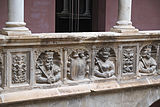Reales Colegios (Tortosa)
The Reales Colegios are a cohesive ensemble of buildings that was built in the 16th century in the Spanish city of Tortosa in the province of Tarragona in the autonomous region of Catalonia . These include the Colegio de San Jaime y San Matías , the Colegio de San Jorge y Santo Domingo and the Church of Santo Domingo. In 1974 the buildings were declared a monument ( Bé Cultural d'Interès Nacional ).
Colegio de San Jaime y San Matías
The Colegio de San Jaime y San Matías , also known as Colegio de arriba (the upper school), was founded in 1544 to teach the Christian faith to the children of the Morisci , the Moors who converted to Christianity after the Reconquista . Today the Archivo Histórico de las Tierras del Ebro (Archive of the Catalan Territory of Terres de l'Ebre ) is here.
portal
The entrance is an elaborately designed Renaissance portal , over which an angel figure is enthroned. Below, in niches framed by fluted columns, stand the two patron saints of Colegios, the apostles James and Matthias . Above the lintel is the coat of arms of Emperor Charles V with the double-headed eagle and the chain of the Order of the Golden Fleece , who, together with his son Philip II, is considered the founder of the Colegios. Fluted columns with Corinthian capitals and angels putti standing on high plinths frame the portal. The arch gussets are studded with floating angels.
patio
The square inner courtyard is surrounded on all four sides by three floors of open galleries. The sculpted decor was created by the sculptor Francisco de Montehermoso. The arcades on the ground floor are supported by columns with vases, heads or plant motifs carved into their bases. The grimaces in the spandrels of the arcades are said to represent Jews or Moors. The consoles in the corners are decorated with symbols of the evangelists .
The kings and queens of Aragon are depicted with their coats of arms on the parapets of the first floor . The series begins with the Count of Barcelona, Raimund Berengar IV , and his wife and Queen of Aragon, Petronella . The last couple is Philip III. and his wife Margaret of Austria . The chubby faces in the corners of the first floor symbolize the four winds. The heads in the medallions of the arcade spandrels represent the twelve apostles .
Blanka von Anjou, Alfons IV. And Theresa von Entanza, Peter IV.
Peter IV. And Eleanor of Sicily , John I and Martha
Emperor Charles V and Isabella of Portugal , Philip II and Anna of Austria , Philip III. and Margaret of Austria
Colegio de San Jorge y Santo Domingo
The Colegio de San Jorge y Santo Domingo , also known as Colegio de abajo called (lower school), was one of the Dominicans led theological college. His patron saints are St. George and St. Dominic . The plans for the construction of the building are attributed to Martín García de Mendoza, who directed construction work on the Cathedral of Tortosa from 1581 to 1615. Apart from the portal, little remains of the original building. After the abolition of Church property in Spain in 1835, the buildings were used as barracks. They suffered great damage during the Spanish Civil War . Today the Escuela Oficial de Idiomas (Official Language School) is housed there.
The inscription is carved above the portal: DOMUS SAPIENTIAE (House of Wisdom). The coat of arms of Philip II of Spain is affixed above between the empty figure niches . The two smaller coats of arms in the arches are reminiscent of the Dominican order.
Santo Domingo Church
The Santo Domingo Church was built in the 16th century, a little later than the two school buildings. Like the Colegio de San Jorge y Santo Domingo, the church was also used as a barracks after the disamortization . Today the Centro de Interpretación del Renacimiento (Museum of the Renaissance) is set up here.
portal
The portal is crowned by two putti and the coat of arms of Bishop Juan Izquierdo. Five figure niches framed by Corinthian columns open under the coat of arms. Only four figures are preserved in it. Their heads are cut off, as are the two sculptures on the side of the portal. The arch of the portal is carved with angel heads, the heads of the apostles Peter and Paul are depicted in the medallions of the gussets .
inner space
The single-nave church has no transept ; side chapels are inserted between the buttresses . The tombstones of Baltasar Sorió and Bishop Juan Izquierdo , who both supported the construction of the Reales Colegios, are placed in the church.
literature
- Reales Colegios de Tortosa leaflet . Edited by Ajuntament de Tortosa and Archivo Histórico de las Tierras del Ebro
Web links
- Reales Colegios Tortosa Official Website, accessed April 11, 2013 (Catalan, Spanish)
- Reials Col·legis de Sant Lluís i Sant Domènec Generalitat de Catalunya, accessed April 11, 2013 (Catalan)
- Los Reales Colegios Terres de l'Ebre, accessed on April 11, 2013 (Spanish, German)
Individual evidence
- ↑ Reials Col·legis de Sant Lluís i Sant Domènec. (No longer available online.) In: Inventory of historical buildings. Generalitat de Catalunya, formerly in the original ; Retrieved April 11, 2013 (Catalan). ( Page no longer available , search in web archives ) Info: The link was automatically marked as defective. Please check the link according to the instructions and then remove this notice.
Coordinates: 40 ° 48 ′ 53.3 " N , 0 ° 31 ′ 29.8" E









